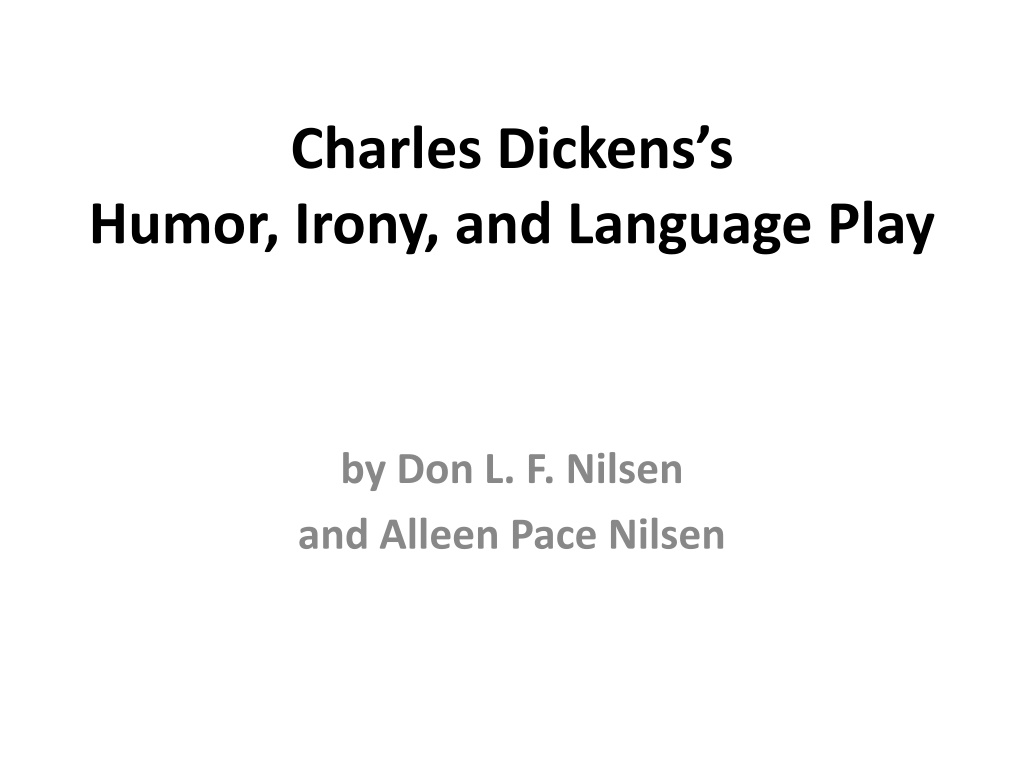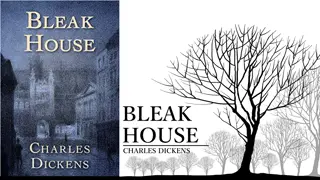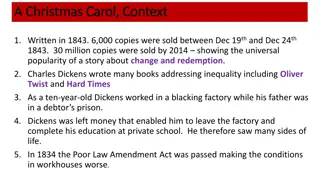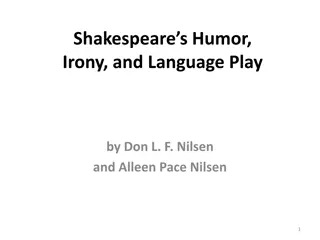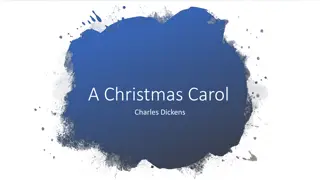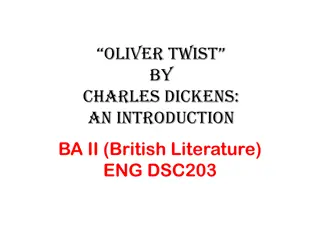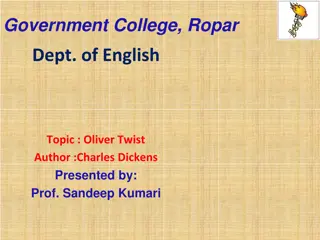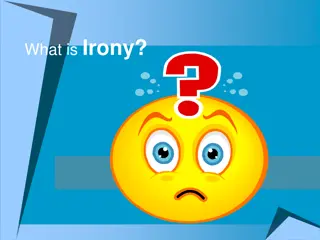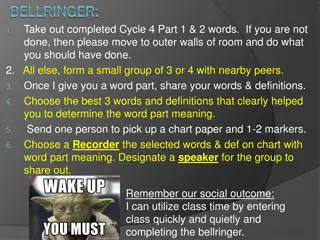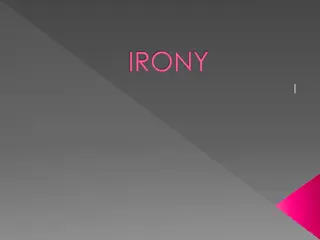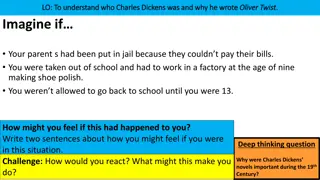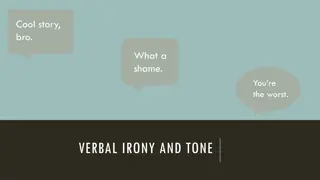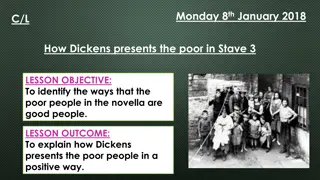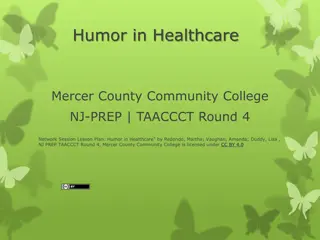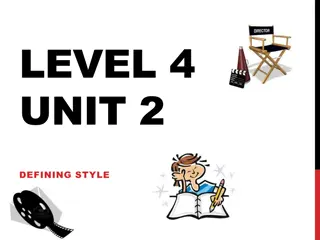Charles Dickens: Humor, Irony, and Language Play
Explore the world of Charles Dickens through his unique humor, irony, and language play. Delve into his novels categorized as Comedies of Manners and Comedies of Humours, with a focus on the diverse characters he created. Discover how Dickens skillfully evokes strong emotions to tackle serious themes with a touch of humor throughout his writing career.
Download Presentation

Please find below an Image/Link to download the presentation.
The content on the website is provided AS IS for your information and personal use only. It may not be sold, licensed, or shared on other websites without obtaining consent from the author.If you encounter any issues during the download, it is possible that the publisher has removed the file from their server.
You are allowed to download the files provided on this website for personal or commercial use, subject to the condition that they are used lawfully. All files are the property of their respective owners.
The content on the website is provided AS IS for your information and personal use only. It may not be sold, licensed, or shared on other websites without obtaining consent from the author.
E N D
Presentation Transcript
Charles Dickenss Humor, Irony, and Language Play by Don L. F. Nilsen and Alleen Pace Nilsen
Charles Dickens (1812-1870) Dickens has a special talent for evoking strong emotions that result in laughter, terror, and/or pathos. These emotions are used to support his dominant themes and effects, and although the earlier novels tend to be lighter in tone and the later novels more serious, there is a seriousness in his humor thoughout his writing career. James Kincaid said, Generally speaking, as Dickens progressed he used humour for perhaps more serious purposes, attacking and persuading the reader more and more subtly (Kincaid 4). 2
Charles Dickenss novels fall into two categories: Comedies of Manners: where social, family, and political hierarchies are satirized, and Comedies of Humours: where the characters are seen as eccentrics, or even grotesques. 3
Two Kinds of Humours Characters Northrup Frye feels that Dickens has two types of humours characters, the genial, generous, and lovable ones, and the absurd or sinister ones. Typically the characters in the congenial society have amiable and harmless eccentricities, while the humours characters in the obstructing society reinforce the false standards and values of that society (Frye 56-57). 4
Bleak House vs Pickwick Papers Humours Characters In Bleak House, Smallweed is the miser, Chadband is the hypocrite, Skimpole and Turveydrop are the parasites, and Mrs. Jellyby is the pedant. In Pickwick Papers, Mr. Winkle is the duffer sportsman, whose pretensions go far beyond his performance. Mr. Winkle, however, represents another humour as well the pleasant young man who breaks down family opposition on both sides to acquire a pleasant young woman (Frye 57). Other humours characters in The Pickwick Papers include Mr. Tupman the incautious lover, Mr. Snodgrass, the melancholy poet, and of course Mr. Pickwick, the pedant. 5
Dickens Characters are Distorted Elton Smith says that for Charles Dickens, everyone is larger than life or smaller than life, but never just life size. Some Dickens characters, like Little Nell, and Oliver Twist, are Perfect Innocents. We suffer and weep for these characters, but we are not allowed to laugh at them because we know that they will die closing innocent blue eyes upon a world that taught them nothing. 6
Worldly Innocents and Villains David Copperfield, Pip, and Mr. Pickwick are Worldly Innocents, because their experiences have shaped them, and they have a capacity for growth. Scrooge is an example of a Villain, who mistreats his employees. But we can laugh at Scrooge because he is scared into change by the ghosts. 7
Targets of Dickens Satires Dickens novels can be seen as ironic tragi- comedies of deception. Dickens targets the injustices of the nineteenth century, namely, poor houses, boys boarding schools, the lack of education for women, the tyrannies of family life, the over reliance on alcohol, and the effects of poverty. 8
The Pickwick Papers (1836-1837) Many of Dickens s novels were first published serially in London newspapers. Number Four of The Pickwick Papers introduced two strikingly colorful Cockney characters, Sam Weller, and his father, Tony Weller, the fat coachman. Sam was impudent, but he was warmhearted. His worldly-wise anecdotes were told in a strong Cockney accent that made him an ideal foil for Mr. Pickwick s innocence and benevolence. 9
Comparing Samuel Pickwick with Don Quixote The Pickwick Papers is a burlesque of the touring and sporting clubs in England in Victorian times. Both Samuel Pickwick and Don Quixote run around trying to redress evils, and both (because of their naivet ) invariably end up looking ridiculous. This comparison is strengthened by comparing Sam Weller with Sancho Panza. Weller s speech is as full of farcical comparisons as was Sancho Panza s speech full of proverbs. About eighty percent of the Wellerisms in The Pickwick Papers are either morbid, or else they deal with such things as debt, unhappy marriage, misanthropy, or general social discomfort. When John Smauker says that the Bath waters are killibeate, Sam responds, I don t know much about that ere . I thought they d a wery strong flavour o warm flat irons. 10
Nicholas Nickleby (1837-1839) Dickens describes Mr. Squeers as being not prepossessing. He had but one eye, and the popular prejudice runs in favor of two. The eye he had was unquestionably useful, but decidedly not ornamental: being of a greenish grey, and in shape resembling the fan-light of a street door. The blank side of his face was much wrinkled and puckered up, which gave him a very sinister appearance, especially when he smiled, at which times his expression bordered closely on the villainous. 11
Mr. Squeers wore a white neckerchief with long ends, and a suit of trousers a great deal too short; he appeared ill at ease in his clothes, as if he were in a perpetual state of astonishment at finding himself so respectable. 12
Oliver Twist (1838-1839) In Oliver Twist, Mr. Gamsfield is the overseer of the chimney sweeps. He makes readers laugh by lighting dry straw fires while the boys are in the chimneys. Boys is wery obstinit, and wery lazy, gen lmen, and there s nothink like a good hot blaze to make em come down vith a run. It s humane too, gen lmen, acause, even if they ve stuck in the chimbley, roasting their feet makes em struggle to hextricate theirselves. 13
The Old Curiosity Shop (1841) The Old Curiosity Shop is one of the characters in this novel. Northrup Frye considers it to be a threshold symbol of the entrance into the grotesque world, like the rabbit-hole and mirror in the Alice books. Northrup Frye says that The Old Curiosity Shop is a melodrama, in which the the mainspring of melodramatic action is, like that of humorous action, mainly obsession (76). 14
The most memorable character in The Old Curiosity Shop is Daniel Quilp. Quilp is a dwarf with the head of a giant. He is a combination of a prankster and a villain. In Chapter 48 of The Old Curiosity Shop, Quilp takes a carriage ride with Mrs. Nubbles: It was some gratification to Mr. Quilp to find, as he took his place upon the roof, that Kit s mother was alone inside; from which circumstance he derived in the course of the journey much cheerfulness of spirit, inasmuch as her solitary condition enabled him to terrify her with many extraordinary annoyances; such as hanging over the side of the coach at great risk of his life, and staring in with his great goggle eyes, which seemed in hers the more horrible from his face being upside down. 15
Unnecessary Detail? George Orwell considers unnecessary detail to have been the most salient feature of Dickens s writing. An example is when Mr. Jack Hopkins is telling a story at Bob Sawyer s party about a child who had swallowed his sister s necklace: Next day, child swallowed two beads; the day after that, he treated himself to three, and so on, till a week s time he had got through the necklace five-and-twenty beads in all. 16
The sister who was an industrious girl and seldom treated herself to a bit of finery, cried her eyes out at the loss of the necklace; looked high and low for it; but I needn t say, didn t find it. A few days afterwards, the family were at dinner baked shoulder of mutton and potatoes under it the child, who wasn t hungry, was playing about the room, when suddenly there was heard the devil of a noise, like a small hailstorm . 17
Martin Chuzzlewit (1842-1844) In Martin Chuzzlewit, Mr. Tarpley comments on grammar: A Werb is a word as signifies to be, to do, or to suffer (which is all the grammar, and enough too, as ever I wos taught); and if there s a Werb alive, I m it. For I m always a-bein , sometimes a-doin , and continually a-sufferin . In the fourth Chapter of Martin Chuzzlewit, there is a greedy reunion of the Chuzzzlewits and their relatives and friends, the Pecksniffs, Slyme, Spottletoes, and Tigg. Robert Polhemus describes this event as a gathering of funny words (93-94). 18
In Martin Chuzzlewit, Mr. Scadder is described as swinging backwards and forwards in a rocking-chair, with one of his legs planted high up against the door- post, and the other doubled up under him as if he were hatching his foot. The weather being hot, he had no cravat, and he wore his shirt collar wide open, so that every time he spoke something was seen to twitch and jerk up in his throat, like the little hammers in a harpsicord when the notes are struck. Perhaps it was the truth feebly endeavouring to leap from his lips. If so, it never reached them. 19
Robert Polhemus says that in Martin Chuzzlewit, Dickens considers America to be a land of Pecksniffian manifest destiny. America had the same function for Dickens as Lilliput had for Swift. It was a place where he could isolate and satirize major developments and coming distractions of the world (104). 20
When Martin and Mark first arrive in New York, they hear the cries of the newsboys: Here s this morning s New York Family Spy! cried one. Here s this morning s New York Stabber! Here s the New York Sewer! Here s the New York Family Spy! Here s the New York Private Listener. Here s the New York Peeper! Here s the New York Plunderer! Here s the New York Keyhole Reporter! Here s the New York Rowdy Journal! George Ford characterizes the American scenes in Martin Chuzzlewit as open-stopped satire, all the way from newsboys shouting the names of their various newspapers to the swampy land development called Eden. 21
David Copperfield (1850) In David Copperfield, Mr. Micawber is described as a stoutish middle-aged person in a brown surcoat and black tights and shoes, with no more hair upon his head (which was a large one, and very shining) than there is upon an egg. His clothes were shabby, but he had an imposing shirt collar on. He carried a jaunty sort of a stick, with a large pair of rusty tassels on it; and a quizzing glass, hung outside his coat, for ornament, I afterward found, as he very seldom looked through it, and couldn t see anything when he did. 22
When David Copperfield shakes hands with Uriah Heep, he says that his handshake feels as if he had just grasped a frog, his lizardlike spacticity, his involuntary writhing and screwing up of the face, and his red shadowless eyes. Heap embodies the self-abasement that accompanies the obsequiousness by which he wriggles up the social ladder. 23
Great Expectations (1861) In Great Expectations, Miss Havisham can be seen as a tragicomic figure. It is ironic that Pip, a Victorian boy, would perceive a person who looks like a witch, to be a good fairy. According to Henri Talon, Pip must have fancied that he was behaving like the young Knight of romance as he went down on his knee and put Miss Havisham shand to his lips. 24
Conclusion: The Grounding of Dickens Characters Many Dickens characters were grounded in real life. The character of Little Nell in The Old Curiosity Shop was based on Mary Hogarth, Dickens s sister-in-law, who died in Dickens s arms at the age of seventeen. When the character Little Nell died, all of England wept. Mr. Micawber was based on Dickens s father, and Mrs. Nickleby was based on his mother. Mrs. Nickleby speaks in loquacious monologues that are filled with delightful absurdities. Dickens s mother didn t realize that she was the model for Mrs. Nickleby, and Dickens once wrote about Mrs. Nickleby herself, sitting bodily before me in a solid chair [who] once asked me whether I believed there ever was such a woman. 25
Mr. Squeers, the schoolmaster in Nicholas Nickleby was also taken from real life, and the portrait was painted so well, and so close to real life that the person on whom the sketch was based suffered from a premature death. Hesketh Pearson notes that Dickens s portrayal of the Yorkshire schools was so devastating that the school system drastically changed, and schools like the ones he described were ridiculed out of existence. 26
Charles Dickenss Humor Charles Dickens s Humor: http://en.wikipedia.org/wiki/Charles_Dickens 27
